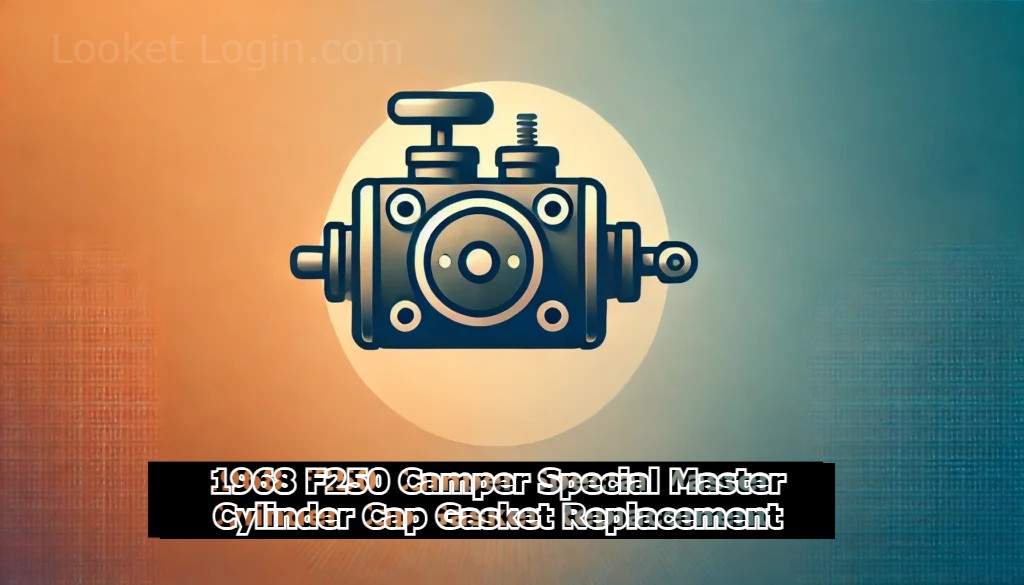Introduction
Is your 1968 F250 Camper Special giving you a headache? If you’ve noticed brake fluid leaks or a spongy brake pedal, it might be time for a 1968 F250 Camper Special master cylinder cap gasket replacement. Don’t worry, though – replacing this small but crucial part can breathe new life into your classic truck’s braking system.
Whether you’re a seasoned mechanic or a DIY enthusiast, tackling this repair can seem daunting at first. But fear not! With the right guidance, tools, and a bit of patience, you can restore your F250’s braking performance to its former glory. In this comprehensive guide, we’ll walk you through the entire process of replacing the master cylinder cap gasket on your 1968 F250 Camper Special.
From understanding the unique features of your vintage truck to identifying signs of gasket failure, we’ve got you covered. We’ll take you step-by-step through the replacement process, sharing expert tips and tricks along the way. So, grab your toolbox and let’s dive into the world of classic Ford truck maintenance!
Understanding the 1968 F250 Camper Special
Key features of the 1968 F250 Camper Special
The 1968 F250 Camper Special was a unique offering from Ford, designed to cater to the growing recreational vehicle market. Here are some of its standout features:
- Heavy-duty suspension
- Increased payload capacity
- Wider track for improved stability
- Optional auxiliary fuel tank
- Upgraded cooling system
| Feature | Purpose |
| Heavy-duty suspension | Enhanced load-bearing capacity |
| Wider track | Improved stability with camper attached |
| Auxiliary fuel tank | Extended driving range |
| Upgraded cooling | Better engine performance under load |
Importance of the master cylinder in braking system
The master cylinder plays a crucial role in the braking system of the 1968 F250 Camper Special:
- Converts mechanical force to hydraulic pressure
- Distributes brake fluid to wheel cylinders
- Ensures balanced braking across all wheels
- Maintains proper brake pedal feel
Location and function of the master cylinder cap gasket
The master cylinder cap gasket is located at the top of the master cylinder reservoir. Its primary functions include:
- Sealing the brake fluid reservoir
- Preventing contamination of brake fluid
- Maintaining proper brake fluid pressure
A properly functioning gasket is essential for the overall performance and safety of the braking system. Now that we understand the basics of the 1968 F250 Camper Special and its master cylinder components, let’s explore the signs that indicate a failing master cylinder cap gasket.
Signs of a Failing Master Cylinder Cap Gasket
Brake fluid leaks
One of the most obvious signs of a failing master cylinder cap gasket in your 1968 F250 Camper Special is the presence of brake fluid leaks. You may notice small puddles or wet spots around the master cylinder area when the vehicle is parked. These leaks can range from minor seepage to more significant fluid loss.
| Leak Severity | Description | Action Required |
| Minor | Small wet spots or dampness | Monitor closely |
| Moderate | Visible droplets or small puddles | Schedule replacement soon |
| Severe | Large puddles or rapid fluid loss | Immediate replacement needed |
Spongy brake pedal
A spongy or soft brake pedal is another telltale sign of a failing master cylinder cap gasket. This occurs when air enters the brake system due to the compromised seal. You may notice:
- Increased pedal travel before brakes engage
- Inconsistent brake feel
- Need to pump the brakes for effective stopping
Reduced braking performance
As the gasket deteriorates, your 1968 F250 Camper Special may experience:
- Longer stopping distances
- Uneven braking
- Pulling to one side during braking
These issues can significantly compromise your vehicle’s safety and should not be ignored.
Visual inspection indicators
Regular visual inspections can help you catch a failing gasket early:
- Look for wetness or discoloration around the master cylinder cap
- Check for corrosion or rust on surrounding metal components
- Inspect the brake fluid level in the reservoir; a consistently low level may indicate a leak
Now that we’ve covered the signs of a failing master cylinder cap gasket, let’s move on to preparing for the replacement process.
Preparing for the Replacement
Tools and materials needed
To successfully replace the master cylinder cap gasket on your 1968 F250 Camper Special, you’ll need the following tools and materials:
- Socket wrench set
- Flathead screwdriver
- Pliers
- Brake fluid (DOT 3 or DOT 4)
- Clean rags
- Brake cleaner spray
- New master cylinder cap gasket
- Safety glasses
- Disposable gloves
Safety precautions
Before starting the replacement process, ensure you follow these safety measures:
- Park the vehicle on a level surface
- Engage the parking brake
- Wear safety glasses and gloves
- Work in a well-ventilated area
- Avoid skin contact with brake fluid
- Keep a fire extinguisher nearby
| Precaution | Reason |
| Level surface | Prevents vehicle movement |
| Safety gear | Protects eyes and skin |
| Ventilation | Reduces fume inhalation |
| Fire extinguisher | Emergency Preparedness |
Acquiring the correct replacement gasket
To ensure a proper fit and function, follow these steps to acquire the correct replacement gasket:
- Locate the master cylinder cap
- Note the make, model, and year of your F250 Camper Special
- Measure the diameter of the cap
- Visit a local auto parts store or search online
- Provide vehicle information to the seller
- Compare the new gasket with the old one before installation
Now that you have gathered all necessary tools, taken safety precautions, and acquired the correct replacement gasket, you’re ready to proceed with removing the old gasket.
Removing the Old Gasket
Locating the master cylinder
The master cylinder on a 1968 F250 Camper Special is typically located on the driver’s side of the engine compartment, near the firewall. It’s a cylindrical component connected to the brake lines. To help you identify it:
| Component | Description | Location |
| Master Cylinder | Cylindrical metal component | Driver’s side, near firewall |
| Brake Lines | Metal tubes connected to the cylinder | Extending from the cylinder |
| Brake Fluid Reservoir | Plastic or metal container on top | Attached to the master cylinder |
Draining brake fluid
Before removing the cap, drain the brake fluid to prevent spills:
- Place a catch pan under the master cylinder
- Use a turkey baster or syringe to remove fluid from the reservoir
- Dispose of old brake fluid properly – it’s hazardous waste
Removing the master cylinder cap
Carefully remove the cap to access the gasket:
- Clean the area around the cap to prevent debris from falling in
- Unscrew the cap slowly, watching for any remaining fluid
- Lift the cap straight up to avoid damaging the threads
Inspecting for damage or corrosion
With the cap removed, inspect the area thoroughly:
- Check the cap for cracks or wear
- Examine the cylinder opening for rust or corrosion
- Look for debris or contamination in the fluid reservoir
Now that we’ve removed the old gasket and inspected the components, we’re ready to move on to installing the new gasket. This step is crucial for ensuring proper function and preventing leaks in your 1968 F250 Camper Special’s braking system.
Installing the New Gasket
Cleaning the master cylinder cap and housing
Before installing the new gasket, it’s crucial to thoroughly clean the master cylinder cap and housing. Use a lint-free cloth and brake cleaner to remove any debris, old gasket material, or brake fluid residue. Pay special attention to the sealing surfaces to ensure a proper seal.
Properly positioning the new gasket
Carefully place the new gasket onto the master cylinder housing, ensuring it’s properly aligned. Avoid stretching or twisting the gasket, as this can lead to leaks. Some gaskets may have a specific orientation, so consult your vehicle’s manual if necessary.
Reattaching the master cylinder cap
Gently place the master cylinder cap onto the housing, making sure the gasket stays in position. Tighten the cap bolts in a star pattern to ensure even pressure distribution. Use a torque wrench to tighten the bolts to the manufacturer’s specifications.
Refilling brake fluid
After installation, it’s time to refill the brake fluid. Here’s a step-by-step guide:
- Check your vehicle’s manual for the recommended brake fluid type
- Clean the area around the fill cap to prevent contamination
- Remove the fill cap and slowly pour in new brake fluid
- Fill to the “MAX” line, but don’t overfill
| Brake Fluid Type | Recommended Use |
| DOT 3 | Most older vehicles |
| DOT 4 | High-performance and newer vehicles |
| DOT 5 | Specialty applications (not for most vehicles) |
Remember to properly dispose of any old brake fluid, as it’s harmful to the environment. With the new gasket installed and the system refilled, you’re ready to move on to the post-replacement procedures to ensure everything is working correctly.
Post-Replacement Procedures
Bleeding the brake system
After replacing the master cylinder cap gasket on your 1968 F250 Camper Special, it’s crucial to bleed the brake system. This process removes air bubbles that may have entered during the replacement. Here’s a step-by-step guide:
- Start with the brake furthest from the master cylinder
- Have an assistant pump the brake pedal
- Open the bleeder valve and allow fluid to flow
- Close the valve before the pedal reaches the floor
- Repeat until no air bubbles are visible
| Brake Order | Location |
| 1 | Right rear |
| 2 | Left rear |
| 3 | Right front |
| 4 | Left front |
Testing brake performance
Once the system is bled, it’s time to test the brakes:
- Start the engine and pump the brake pedal
- Check for a firm pedal feel
- Test drive in a safe area
- Perform gradual stops
- Test emergency braking (in a controlled environment)
Monitoring for leaks
After the replacement and testing, keep an eye out for potential leaks:
- Check the master cylinder area daily for the first week
- Look for fluid puddles under the truck
- Monitor brake fluid levels regularly
- Pay attention to any changes in brake pedal feel
If you notice any issues during these post-replacement procedures, it’s essential to address them immediately to ensure the safety and proper functioning of your 1968 F250 Camper Special’s braking system. With these steps complete, you can be confident in your brake system’s performance. Next, we’ll explore some maintenance tips to keep your newly replaced gasket and overall brake system in top condition for years to come.
Maintenance Tips for Longevity
Regular brake system inspections
To ensure the longevity of your 1968 F250 Camper Special’s master cylinder cap gasket and overall brake system, regular inspections are crucial. Perform these checks at least twice a year:
- Visual inspection of brake lines
- Check for fluid leaks around the master cylinder
- Examine brake pedal feel and responsiveness
- Inspect brake pads and rotors for wear
| Inspection Point | Frequency | What to Look For |
| Brake fluid level | Monthly | Maintain between MIN and MAX lines |
| Brake hoses | Every 6 months | Cracks, bulges, or leaks |
| Brake pedal | Every oil change | Unusual play or sinking |
| Master cylinder | Annually | Corrosion, leaks, or damage |
Proper brake fluid maintenance
Maintaining the brake fluid is essential for the health of your master cylinder cap gasket:
- Use DOT 3 or DOT 4 brake fluid as recommended by Ford
- Replace brake fluid every 2 years or 30,000 miles
- Keep the brake fluid reservoir clean and sealed
- Avoid contamination by using only fresh, unopened brake fluid
Addressing issues promptly
Quick action can prevent minor issues from becoming major problems:
- Investigate any unusual noises or pedal feel immediately
- Replace worn components before they cause system-wide damage
- Clean and lubricate moving parts during routine maintenance
- Consult a professional if you’re unsure about any brake system symptoms
By following these maintenance tips, you’ll extend the life of your 1968 F250 Camper Special’s master cylinder cap gasket and ensure safer, more reliable braking performance. Regular care will help you avoid frequent replacements and maintain the integrity of your classic truck’s brake system.
Conclusion
Replacing the master cylinder cap gasket on a 1968 F250 Camper Special is a crucial maintenance task that can significantly improve your vehicle’s braking performance and safety. By following the steps outlined in this guide, you can successfully replace the gasket and ensure your classic truck continues to operate smoothly.
Remember to regularly inspect your master cylinder and other brake components for signs of wear or damage. Proper maintenance and timely replacements will not only extend the life of your 1968 F250 Camper Special but also provide peace of mind during your travels. Don’t hesitate to consult a professional mechanic if you encounter any difficulties during the replacement process or if you notice persistent brake issues.





